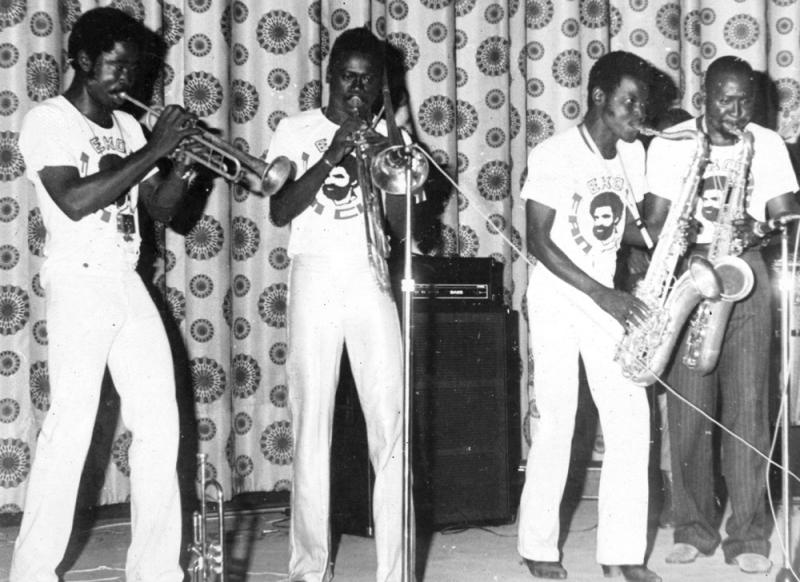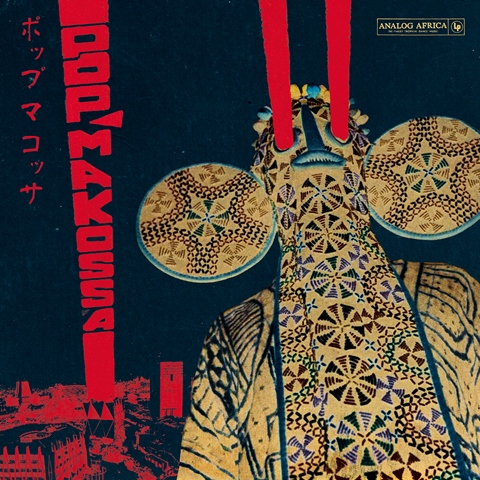Reissue CDs Weekly: Pop Makossa | reviews, news & interviews
Reissue CDs Weekly: Pop Makossa
Reissue CDs Weekly: Pop Makossa
Celebration of Cameroon’s ‘Invasive Dance Beat’ is a blast

In Summer 1973, Manu Dibango’s “Soul Makossa” peaked at 35 on the American charts. Originally the A-side of a France-only single issued in 1972, the song had been discovered by New York DJ David Mancusso. After Mancusso repeatedly played it, “Soul Makossa” was licensed by Atlantic, charted and became integral to what was bracketed as disco music.
As a style, makossa predated Dibango’s single. Born in Cameroon, it fused musical genres from the region and further afield. The liner notes of Pop Makossa explain “If makossa could be expressed as a single mathematical formula it would be: Bolobo + Essewé + Assiko + Congolese Rumba + Merengue + High-Life = Makossa.” Strictly speaking, the overtly James Brown-esque “Soul Makossa” wasn’t makossa but it did draw the Anglophone world’s attention to the word and Cameroon’s popular music.
 Four decades on, Pop Makossa - The Invasive Dance Beat of Cameroon 1976–1984 is a twelve track World Music compilation kicking off with Dream Stars previously unreleased “Pop Makossa Invasion”. Although musically structured and titled as a nod to Dibango’s hit, and of unknown date, it can’t be interpreted as disco. Seemingly recorded at the bottom of a well, it's sparse, heavy on reverb and defined by clipped funk guitar, a bass line which hypnotically runs up and down the scales a note at a time and minimal, repetitive drumming. The vocals are mainly chanted repetitions of the title. A deconstruction of “Soul Makossa”, it sounds like a precursor of New York art-funk outfit Liquid Liquid. It’s great.
Four decades on, Pop Makossa - The Invasive Dance Beat of Cameroon 1976–1984 is a twelve track World Music compilation kicking off with Dream Stars previously unreleased “Pop Makossa Invasion”. Although musically structured and titled as a nod to Dibango’s hit, and of unknown date, it can’t be interpreted as disco. Seemingly recorded at the bottom of a well, it's sparse, heavy on reverb and defined by clipped funk guitar, a bass line which hypnotically runs up and down the scales a note at a time and minimal, repetitive drumming. The vocals are mainly chanted repetitions of the title. A deconstruction of “Soul Makossa”, it sounds like a precursor of New York art-funk outfit Liquid Liquid. It’s great.
The other cuts collected on Pop Makossa are fuller sounding, feature regular instrumental interplay and have a production gloss. Highlights include Eko’s driving, brass-punctuated high-life-influenced “M’ongele M’am” (1980), Olinga Gaston’s (pictured below left in 1978) sinuous, funk-bedded “Ngon Engap” (1977), Bernard Ntone’s rolling “Mussoliki” (1977) and Pasteur Lappé’s “Sanaga Calypso” (1981) with its bubbling syn-drums, call-response vocals and stabbing keyboards.
 Overall – “Pop Makossa Invasion” excepted – Pop Makossa is compiled as a sample of upfront dance-floor oriented cuts which aren’t going to cause any brow furrowing. It is about the beat. Though most of the names are unfamiliar, it is not a journey through challenging territory or a rewriting of musical orthodoxy. As such, it’s a terrific listen.
Overall – “Pop Makossa Invasion” excepted – Pop Makossa is compiled as a sample of upfront dance-floor oriented cuts which aren’t going to cause any brow furrowing. It is about the beat. Though most of the names are unfamiliar, it is not a journey through challenging territory or a rewriting of musical orthodoxy. As such, it’s a terrific listen.
Beyond the music, the fun of Pop Makossa is that it opens doors. Without digging really hard, it is impossible to know whether, say, “Ngon Engap” represents Olinga Gaston’s oeuvre as a whole. Of him, the liner notes titillatingly say “no one who did more to modernise Bikutsi music in the 1970s than Olinga Gaston, a singer and guitarist known for his enchanting voice and his unique, balafon-inspired guitar style. Unfortunately we know very little about his life, and most of what we do know is related directly to his professional relationship with Manu Dibango, Cameroon’s best-known musician.”
The well-illustrated booklet’s in-depth liner notes include a lengthy scene-setting essay and artist-by-artist biographies drawing from interviews. The story of radio DJ-newspaper editor-journalist turned songwriter and now seemingly vanished Pasteur Lappé is extraordinary. Curiously, Dream Stars and their “Pop Makossa Invasion” are mentioned nowhere. Nonetheless, for seasoned listeners of west-central African music and the less committed alike, the all-killer, no-filler Pop Makossa is a blast.
- Next week: The previously unheard music of songwriter-hairdresser Lynn Castle
- Read more reissue reviews on theartsdesk
Share this article
The future of Arts Journalism
You can stop theartsdesk.com closing!
We urgently need financing to survive. Our fundraising drive has thus far raised £49,000 but we need to reach £100,000 or we will be forced to close. Please contribute here: https://gofund.me/c3f6033d
And if you can forward this information to anyone who might assist, we’d be grateful.

Subscribe to theartsdesk.com
Thank you for continuing to read our work on theartsdesk.com. For unlimited access to every article in its entirety, including our archive of more than 15,000 pieces, we're asking for £5 per month or £40 per year. We feel it's a very good deal, and hope you do too.
To take a subscription now simply click here.
And if you're looking for that extra gift for a friend or family member, why not treat them to a theartsdesk.com gift subscription?
more New music
 Sad and Beautiful World: Mavis Staples offers words of wisdom
Soul sister sings on
Sad and Beautiful World: Mavis Staples offers words of wisdom
Soul sister sings on
 theartsdesk on Vinyl 93: Led Zeppelin, Blawan, Sylvester, Zaho de Sagazan, Sabres of Paradise, Hot Chip and more
The most extensive, wide-ranging record reviews in the galaxy
theartsdesk on Vinyl 93: Led Zeppelin, Blawan, Sylvester, Zaho de Sagazan, Sabres of Paradise, Hot Chip and more
The most extensive, wide-ranging record reviews in the galaxy
 Suzanne Vega and Katherine Priddy, Royal Albert Hall review - superlative songwriters
Two brilliant voices fill the Royal Albert Hall
Suzanne Vega and Katherine Priddy, Royal Albert Hall review - superlative songwriters
Two brilliant voices fill the Royal Albert Hall
 Kali Malone and Drew McDowell generate 'Magnetism' with intergenerational ambience
Young composer and esoteric veteran achieve alchemical reaction in endless reverberations
Kali Malone and Drew McDowell generate 'Magnetism' with intergenerational ambience
Young composer and esoteric veteran achieve alchemical reaction in endless reverberations
 Benson Boone, O2 London review - sequins, spectacle and cheeky charm
Two hours of backwards-somersaults and British accents in a confetti-drenched spectacle
Benson Boone, O2 London review - sequins, spectacle and cheeky charm
Two hours of backwards-somersaults and British accents in a confetti-drenched spectacle
 Midlake's 'A Bridge to Far' is a tour-de-force folk-leaning psychedelic album
The Denton, Texas sextet fashions a career milestone
Midlake's 'A Bridge to Far' is a tour-de-force folk-leaning psychedelic album
The Denton, Texas sextet fashions a career milestone
 'Vicious Delicious' is a tasty, burlesque-rockin' debut from pop hellion Luvcat
Contagious yarns of lust and nightlife adventure from new pop minx
'Vicious Delicious' is a tasty, burlesque-rockin' debut from pop hellion Luvcat
Contagious yarns of lust and nightlife adventure from new pop minx
 Music Reissues Weekly: Hawkwind - Hall of the Mountain Grill
Exhaustive box set dedicated to the album which moved forward from the ‘Space Ritual’ era
Music Reissues Weekly: Hawkwind - Hall of the Mountain Grill
Exhaustive box set dedicated to the album which moved forward from the ‘Space Ritual’ era
 'Everybody Scream': Florence + The Machine's brooding sixth album
Hauntingly beautiful, this is a sombre slow burn, shifting steadily through gradients
'Everybody Scream': Florence + The Machine's brooding sixth album
Hauntingly beautiful, this is a sombre slow burn, shifting steadily through gradients
 Cat Burns finds 'How to Be Human' but maybe not her own sound
A charming and distinctive voice stifled by generic production
Cat Burns finds 'How to Be Human' but maybe not her own sound
A charming and distinctive voice stifled by generic production
 Todd Rundgren, London Palladium review - bold, soul-inclined makeover charms and enthrals
The wizard confirms why he is a true star
Todd Rundgren, London Palladium review - bold, soul-inclined makeover charms and enthrals
The wizard confirms why he is a true star

Add comment